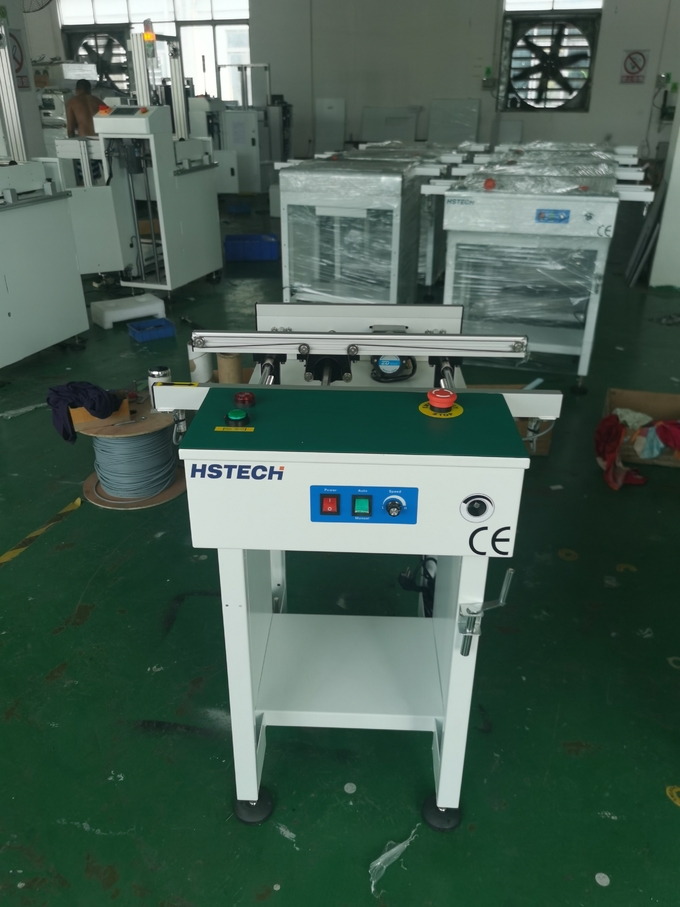SMEMA Signal PCB Handling Equipment SMT Conveyor With ESD Flat Belt
For PCB Buffering
Introduce
The SMT conveyor is suitable for the connection between SMT and AI
production lines. It can also be used for PCB buffering,
inspection, testing or manual insertion of electronic components.
It can also be used for signal connection with other equipment. The
connecting platform is divided into single track, double track,
telescopic lift. Today we will introduce the working principle and
product features of the docking station.
Features
1, Thickness stable stainless steel machine body.
2, Max 390mm PCB width, hand crand width adjustment.
3, Transporting speed adjustment by Knob.
4, ESD green color work table.
5, Aluminum alloy transporting rail.
6, LED button control, speed adjustment motor.
7, Optional function available, tower light, inspection, dust
cover, etc.
8, Customized requirement available.
9, Length available, 600mm, 1000mm, 1500mm, or optional.
10, SMEMA signal for inline connection.
Specification
| Model | HS-C600/HS-C600S |
| Power Supply | AC220V or AC110V 50/60Hz |
| PCB Size | 50*50~500*390mm |
| Width adjustment | Hand crank |
| PCB Direction | Left to right or right to left |
| Transmission Height | 900 ± 20 mm |
| Transmission Speed | 0.5-20 meters per minute adjustable |
| Track fixed side | front side fixed( or back side fixed for option) |
| Machine Length | 0.5M/0.6M/0.8M/1M/1.5M |
| Options | Light,Fan,Magnnifying,Cover,Inspection |
| Communication signal | SMEMA |
1.Mainly used in SMT production line equipment and equipment link
between the transfer, stop board function.
2. According to the need to increase the detection, function
switching, NG, data memory and other functions.
3. High-strength equipment body to ensure the stability of the
equipment.
4. Smooth stainless steel screws can adjust the width of the rail.
5. Use special aluminium slots to make the transfer track to
prevent pcb jamming.
6. The control system is PLC controlled with standard SMEMA signal
interface.
8. Worktable plate, lighting, static dust cover, cooling fan can be
added as required.
9. Various forms can be customised according to the customer's site
size planning or product production requirements, so as to
facilitate the customer to choose the most reasonable structure.
Application:
Automatic conveying:
SMT conveyor belts can automatically transfer PCBs or other
workpieces from one process to the next.
This greatly improves the automation of the production line and
reduces the workload of manual operations.
Speed control:
SMT conveyor belts can adjust the conveying speed according to
production needs to ensure the reasonable flow of workpieces
between various processes.
Reasonable conveying speed helps to ensure production efficiency
and product quality.
Positioning calibration:
SMT conveyor belts are usually equipped with precise positioning
systems that can accurately deliver workpieces to the specified
insertion or marking positions.
This precise positioning ensures the smooth progress of subsequent
processes.
Multi-process integration:
SMT conveyor belts can be seamlessly integrated with other SMT
equipment such as placement machines, welding machines, marking
machines, etc.
This integration enables the entire production line to work
together efficiently.
Environmental control:
Some SMT conveyor belts also have environmental control functions
such as temperature and humidity to ensure that the workpieces are
in the best conditions for subsequent processes.
This environmental regulation helps to improve product quality and
reliability.
Data collection:
SMT conveyor belts can collect information such as the transfer
time and location of workpieces, providing data support for
production process analysis.
These data help identify bottlenecks in the production line and
optimize overall production efficiency.















